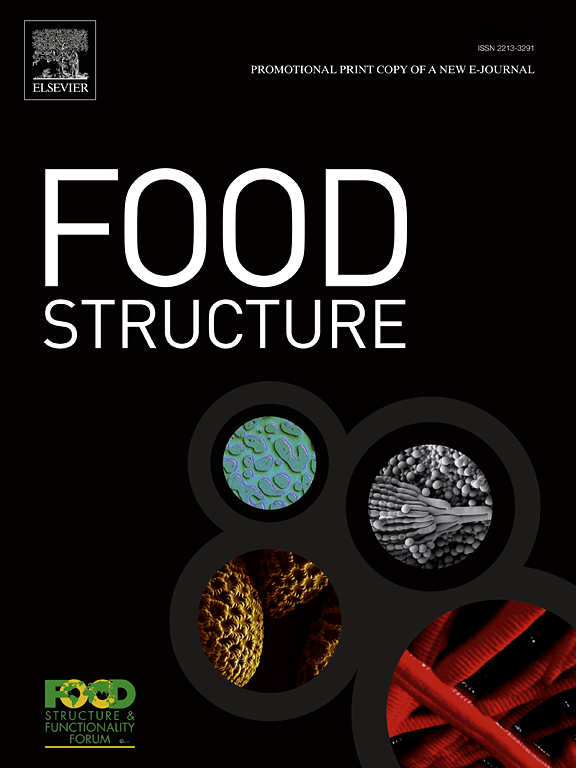Crystallization of wax esters in oleogels – Relevance of chain length and ester bond position
IF 5.9
3区 农林科学
Q1 FOOD SCIENCE & TECHNOLOGY
引用次数: 0
Abstract
A comprehensive data set is presented to elucidate the crystallization and structure formation behavior of pure wax esters (WEs) and their oleogels. X-ray data (WAXS/SAXS), thermal properties (DSC) and microstructure data (BFM and rheology) are discussed for 23 WEs with total carbon numbers (CN) between 24 and 48. Further, the effect of the ester bond position is emphasized. The results clearly show the systematics of WE crystallization. All WEs crystallize in an orthorhombic perpendicular subcell. Crystal lamellae consist of a single molecular layer; depending on the ester bond position, these are orthogonal (ΔCN = +2 and −4) or inclined (62.5°). With increasing CN, the heat of fusion (Δhf) increases linearly, the melting point temperature (TSL) asymptotically. For the same CN, non-symmetric WEs show reduced values of the caloric properties. For identical absolute values of ΔCN, i.e. + 2 and −2, the orthogonal arrangement yields higher Δhf and TSL. Comparing pure WEs and oleogels reveals essentially identical systematics, though WE crystallization in oleogels seems to diverge from ideal solubility. The microstructure shows little dependence on the orientation of the lamellae to the methyl end plane. In general, increasing CN results in a more clearly defined crystal habit with larger crystals and comparatively small gel rigidities (G*max). For the same CN, increasing ΔCN results in less ordered structures with shorter edges and larger G*max values. The data indicate that the caloric properties are more influenced by orthogonal or tilted arrangement. In contrast, the microstructure observations can be better explained by kinetic aspects during crystallization.
油凝胶中蜡酯的结晶——链长和酯键位置的相关性
提出了一套全面的数据集来阐明纯蜡酯(WEs)及其油凝胶的结晶和结构形成行为。对总碳数(CN)在24 ~ 48之间的23种WEs进行了x射线数据(WAXS/SAXS)、热性能(DSC)和微观结构(BFM和流变学)分析。进一步强调了酯键位置的影响。结果清楚地显示了WE结晶的系统性。所有WEs都在正交的垂直亚胞中结晶。晶片由单个分子层组成;根据酯键的位置,它们是正交的(ΔCN = +2和- 4)或倾斜的(62.5°)。随着CN的增大,熔点温度(Δhf)线性增大,熔点温度(TSL)渐近增大。对于相同的CN,非对称的WEs表现出降低的热学性质值。对于相同的ΔCN绝对值,即+ 2和- 2,正交排列得到更高的Δhf和TSL。比较纯WEs和油凝胶可以发现本质上相同的系统,尽管油凝胶中的WE结晶似乎偏离了理想的溶解度。微观结构与片层与甲基端面的取向关系不大。一般来说,CN的增加导致晶体习惯更清晰,晶体更大,凝胶刚度相对较小(G*max)。对于相同的CN,增加ΔCN会导致更少的有序结构、更短的边和更大的G*max值。结果表明,正交或倾斜排列对热学性能的影响更大。相比之下,微观结构观察可以更好地解释动力学方面的结晶过程。
本文章由计算机程序翻译,如有差异,请以英文原文为准。
求助全文
约1分钟内获得全文
求助全文
来源期刊

Food Structure-Netherlands
Chemical Engineering-Bioengineering
CiteScore
7.20
自引率
0.00%
发文量
48
期刊介绍:
Food Structure is the premier international forum devoted to the publication of high-quality original research on food structure. The focus of this journal is on food structure in the context of its relationship with molecular composition, processing and macroscopic properties (e.g., shelf stability, sensory properties, etc.). Manuscripts that only report qualitative findings and micrographs and that lack sound hypothesis-driven, quantitative structure-function research are not accepted. Significance of the research findings for the food science community and/or industry must also be highlighted.
 求助内容:
求助内容: 应助结果提醒方式:
应助结果提醒方式:


